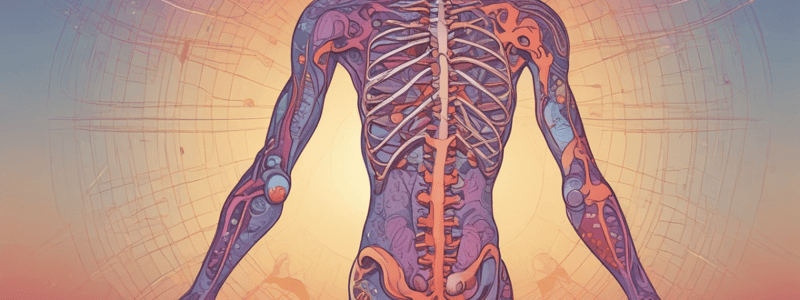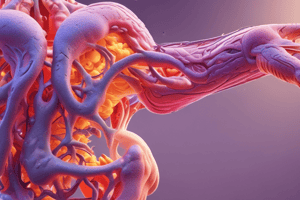Podcast
Questions and Answers
What is the main characteristic that distinguishes systemic autoimmune diseases from other diseases?
What is the main characteristic that distinguishes systemic autoimmune diseases from other diseases?
- Production of a large variety of autoantibodies
- Inflammation of the joints
- Frequent remissions and exacerbations
- Autoimmune reaction causing inflammation in areas of the body where it is not needed (correct)
What is the most common age range for Systemic Lupus Erythematosus diagnosis?
What is the most common age range for Systemic Lupus Erythematosus diagnosis?
- 10-20 years old
- 20-40 years old (correct)
- 60-80 years old
- 40-60 years old
What is the term for diseases that affect the connective tissue in the body?
What is the term for diseases that affect the connective tissue in the body?
- Collagen vascular diseases
- Connective tissue diseases
- Systemic autoimmune diseases
- All of the above (correct)
What is the term for the production of antibodies against the body's own tissues?
What is the term for the production of antibodies against the body's own tissues?
What is the role of the liver in the development of Systemic Lupus Erythematosus?
What is the role of the liver in the development of Systemic Lupus Erythematosus?
What is the characteristic feature of the disease process in Systemic Lupus Erythematosus?
What is the characteristic feature of the disease process in Systemic Lupus Erythematosus?
What is the most characteristic autoantibody in Systemic Lupus Erythematosus?
What is the most characteristic autoantibody in Systemic Lupus Erythematosus?
What is the term for the study and treatment of systemic autoimmune diseases?
What is the term for the study and treatment of systemic autoimmune diseases?
What is the primary mechanism of tissue damage in Systemic Lupus Erythematosus (SLE)?
What is the primary mechanism of tissue damage in Systemic Lupus Erythematosus (SLE)?
What is the percentage of people with SLE who experience arthralgias or arthritis?
What is the percentage of people with SLE who experience arthralgias or arthritis?
What is the name of the antibody that is often present in people with SLE?
What is the name of the antibody that is often present in people with SLE?
What is the leading cause of disability in middle-aged and older populations in the US?
What is the leading cause of disability in middle-aged and older populations in the US?
What is the hallmark of the osteoarthritic process?
What is the hallmark of the osteoarthritic process?
What is the result of the loss of proteoglycans from articular cartilage?
What is the result of the loss of proteoglycans from articular cartilage?
What is the percentage of people with Osteoarthritis who experience joint disease?
What is the percentage of people with Osteoarthritis who experience joint disease?
What is the name of the process by which articular cartilage becomes damaged in Osteoarthritis?
What is the name of the process by which articular cartilage becomes damaged in Osteoarthritis?
What is the result of the changes in the proteoglycans in Osteoarthritis?
What is the result of the changes in the proteoglycans in Osteoarthritis?
What is the effect of normal aging on the proteoglycan content in cartilage?
What is the effect of normal aging on the proteoglycan content in cartilage?
What is the main component of cartilage?
What is the main component of cartilage?
What is the primary cause of joint pain and stiffness in osteoarthritis?
What is the primary cause of joint pain and stiffness in osteoarthritis?
What is the typical duration of morning stiffness in osteoarthritis?
What is the typical duration of morning stiffness in osteoarthritis?
What is the most common site of initial attack in gout?
What is the most common site of initial attack in gout?
What is the characteristic feature of tophi in gout?
What is the characteristic feature of tophi in gout?
What is the third clinical stage of gout?
What is the third clinical stage of gout?
Study Notes
What is Rheumatology?
- Study and treatment of systemic autoimmune diseases, also known as collagen vascular diseases or connective tissue diseases
- Autoimmune reaction causes inflammation in various body parts, leading to pain, swelling, and organ damage
- Can affect any part of the body, including eyes, skin, nerves, kidneys, lungs, and heart
Common Systemic Autoimmune Diseases
- Osteoarthritis
- Rheumatoid arthritis
- Gout
- Ankylosing spondylitis
- Systemic Lupus Erythematosus (SLE)
- Sjogren's Disease
- Scleroderma
Systemic Lupus Erythematosus (SLE)
- More common in women (10:1) and 20-40-year-olds
- Disease process develops slowly, with frequent remissions and exacerbations
- A chronic, multisystem, inflammatory disease
- Pathophysiology involves production of autoantibodies against nucleic acids, histones, ribonucleoproteins, and other nuclear materials
- Immune complexes containing antibody against DNA deposit in tissues, causing tissue damage
- Most common clinical manifestations:
- Arthralgias or arthritis (90%)
- Vasculitis and rash (70-80%)
- Renal disease (40-50%)
- Hematologic abnormalities (50%)
- Cardiovascular diseases (30-50%)
Clinical Findings of SLE
- Facial rash confined to the cheeks (malar rash)
- Discoid rash (raised patches, scaling)
- Photosensitivity
- Oral or nasopharyngeal ulcers
- Nonerosive arthritis of at least two peripheral joints
- Serositis (pleurisy, pericarditis)
- Renal disorder
- Neurologic disorders (seizures or psychosis)
- Hematologic disorders (hemolytic anemia, leukopenia, lymphopenia, or thrombocytopenia)
- Immunologic disorders (antibodies against double-stranded DNA or Smith antigen)
- Presence of antinuclear antibody (ANA)
Arthropathies
- Joint diseases
- Non-inflammatory arthropathy: Osteoarthritis
- Inflammatory Arthropathies:
- Rheumatoid Arthritis (autoimmune)
- Gout (crystals cause inflammation)
- Ankylosing Spondylitis (immune-mediated)
Osteoarthritis
- Most common joint disease
- Leading cause of disability in middle-aged and older populations in the US
- Prevalence is 20% in the elderly
- Most often affects knees, hip, neck, hands, and lower back
- Characterized by:
- Local areas of loss and damage of articular cartilage
- Bone spurs (osteophytes)
- Subchondral bone changes
- Variable degrees of mild synovitis
- Thickening of the joint capsule
Osteoarthritis Pathogenesis
- Primary pathogenesis is degeneration, loss, and disordered repair of articular cartilage
- People with OA have higher levels of pro-inflammatory markers
- Cascade of cytokine, biochemical, and growth factor pathways
- Chondrocytes of articular cartilage become damaged
- Leading to increased remodeling of articular cartilage and loss of smooth, frictionless joint
- Cartilage becomes thin and may be absent over some areas, leaving the underlying subchondral bone unprotected
Osteoarthritis Clinical Manifestations
- Joint pain and stiffness
- Stiffness in the morning and usually brief
- Decreased range of motion
- Crepitus
- Local tenderness
Gout
- Increase in serum urate concentration
- Recurrent attacks of monoarticular arthritis
- Severe pain, swelling, tenderness, and erythema
- 50% of initial attacks are in the great toe metatarsophalangeal joint
- Tophi: Deposits of monosodium urate in and around joints
- Renal disease involving glomerular, tubular, and interstitial tissues and blood vessels
- Formation of renal stones
- 3 clinical stages:
- Asymptomatic Hyperuricemia
- Acute Gouty Arthritis
- Tophaceous Gout
Studying That Suits You
Use AI to generate personalized quizzes and flashcards to suit your learning preferences.
Description
This quiz covers the study and treatment of systemic autoimmune diseases, including collagen vascular diseases and connective tissue diseases, and their effects on various body parts.




